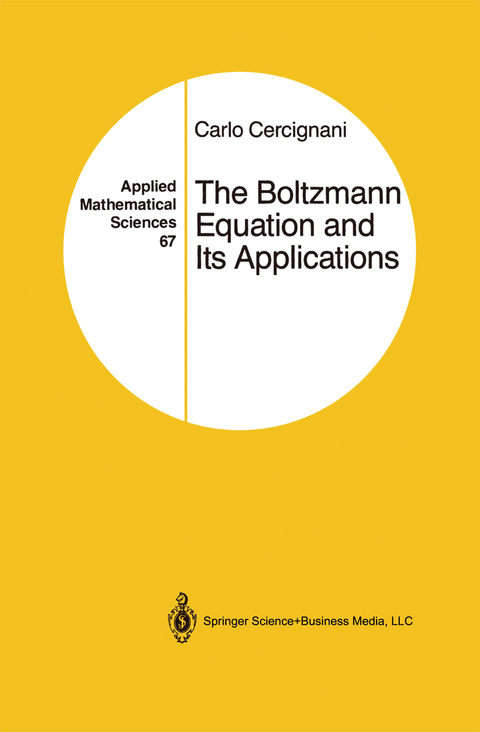
The Boltzmann Equation and Its Applications
Springer-Verlag New York Inc.
978-0-387-96637-3 (ISBN)
Statistical mechanics may be naturally divided into two branches, one dealing with equilibrium systems, the other with nonequilibrium systems. The equilibrium properties of macroscopic systems are defined in principle by suitable averages in well-defined Gibbs's ensembles. This provides a frame work for both qualitative understanding and quantitative approximations to equilibrium behaviour. Nonequilibrium phenomena are much less understood at the present time. A notable exception is offered by the case of dilute gases. Here a basic equation was established by Ludwig Boltzmann in 1872. The Boltzmann equation still forms the basis for the kinetic theory of gases and has proved fruitful not only for a study of the classical gases Boltzmann had in mind but also, properly generalized, for studying electron transport in solids and plasmas, neutron transport in nuclear reactors, phonon transport in superfluids, and radiative transfer in planetary and stellar atmospheres. Research in both the new fields and the old one has undergone a considerable advance in the last thirty years.
I. Basic Principles of The Kinetic Theory of Gases.- 1. Introduction.- 2. Probability.- 3. Phase space and Liouville’s theorem.- 4. Hard spheres and rigid walls. Mean free path.- 5. Scattering of a volume element in phase space.- 6. Time averages, ergodic hypothesis and equilibrium states.- References.- II. The Boltzmann Equation.- 1. The problem of nonequilibrium states.- 2. Equations for the many particle distribution functions for a gas of rigid spheres.- 3. The Boltzmann equation for rigid spheres.- 4. Generalizations.- 5. Details of the collision term.- 6. Elementary properties of the collision operator. Collision invariants.- 7. Solution of the equation Q(f,f) = 0.- 8. Connection between the microscopic description and the macroscopic description of gas dynamics.- 9. Non-cutoff potentials and grazing collisions. Fokker-Planck equation.- 10. Model equations.- References.- III. Gas-Surface Interaction and the H-Theorem.- 1. Boundary conditions and the gas-surface interaction.- 2. Computation of scattering kernels.- 3. Reciprocity.- 4. A remarkable inequality.- 5. Maxwell’s boundary conditions. Accommodation coefficients.- 6. Mathematical models for gas-surface interaction.- 7. Physical models for gas-surface interaction.- 8. Scattering of molecular beams.- 9. The H-theorem. Irreversibility.- 10. Equilibrium states and Maxwellian distributions.- References.- IV, Linear Transport.- 1. The linearized collision operator.- 2. The linearized Boltzmann equation.- 3. The linear Boltzmann equation. Neutron transport and radiative transfer.- 4. Uniqueness of the solution for initial and boundary value problems.- 5. Further investigation of the linearized collision term.- 6. The decay to equilibrium and the spectrum of the collision operator.- 7. Steady one-dimensionalproblems. Transport coefficients.- 8. The general case.- 9. Linearized kinetic models.- 10. The variational principle.- 11. Green’s function.- 12. The integral equation approach.- References.- V. Small and Large Mean Free Paths.- 1. The Knudsen number.- 2. The Hilbert expansion.- 3. The Chapman-Enskog expansion.- 4. Criticism of the Chapman-Enskog method.- 5. Initial, boundary and shock layers.- 6. Further remarks on the Chapman-Enskog method and the computation of transport coefficients.- 7. Free molecule flow past a convex body.- 8. Free molecule flow in presence of nonconvex boundaries.- 9. Nearly free-molecule flows.- References.- VI. Analytical Solutions of Models.- 1. The method of elementary solutions.- 2. Splitting of a one-dimensional model equation.- 3. Elementary solutions of the simplest transport equation.- 4. Application of the general method to the Kramers and Milne problems.- 5. Application to the flow between parallel plates and the critical problem of a slab.- 6. Unsteady solutions of kinetic models with constant collision frequency.- 7. Analytical solutions of specific problems.- 8. More general models.- 9. Some special cases.- 10. Unsteady solutions of kinetic models with velocity dependent collision frequency.- 11. Analytic continuation.- 12. Sound propagation in monatomic gases.- 13. Two-dimensional and three-dimensional problems. Flow past solid bodies.- 14. Fluctuations and light scattering.- References.- VII. The Transition Regime.- 1. Introduction.- 2. Moment and discrete ordinate methods.- 3. The variational method.- 4. Monte Carlo methods.- 5. Problems of flow and heat transfer in regions bounded by planes or cylinders.- 6. Shock-wave structure.- 7. External flows.- 8. Expansion of a gas into a vacuum.- References.- VIII. Theorems on theSolutions of the Boltzmann Equation.- 1. Introduction.- 2. The space homogeneous case.- 3. Mollified and other modified versions of the Boltzmann equation.- 4. Nonstandard analysis approach to the Boltzmann equation.- 5. Local existence and validity of the Boltzmann equation.- 6. Global existence near equilibrium.- 7. Perturbations of vacuum.- 8. Homoenergetic solutions.- 9. Boundary value problems. The linearized and weakly nonlinear cases.- 10. Nonlinear boundary value problems.- 11. Concluding remarks.- References.- References.- Author Index.
| Reihe/Serie | Applied Mathematical Sciences ; 67 |
|---|---|
| Zusatzinfo | XIII, 455 p. |
| Verlagsort | New York, NY |
| Sprache | englisch |
| Maße | 155 x 235 mm |
| Themenwelt | Mathematik / Informatik ► Mathematik ► Angewandte Mathematik |
| Naturwissenschaften ► Physik / Astronomie ► Allgemeines / Lexika | |
| Naturwissenschaften ► Physik / Astronomie ► Theoretische Physik | |
| ISBN-10 | 0-387-96637-4 / 0387966374 |
| ISBN-13 | 978-0-387-96637-3 / 9780387966373 |
| Zustand | Neuware |
| Informationen gemäß Produktsicherheitsverordnung (GPSR) | |
| Haben Sie eine Frage zum Produkt? |
aus dem Bereich


